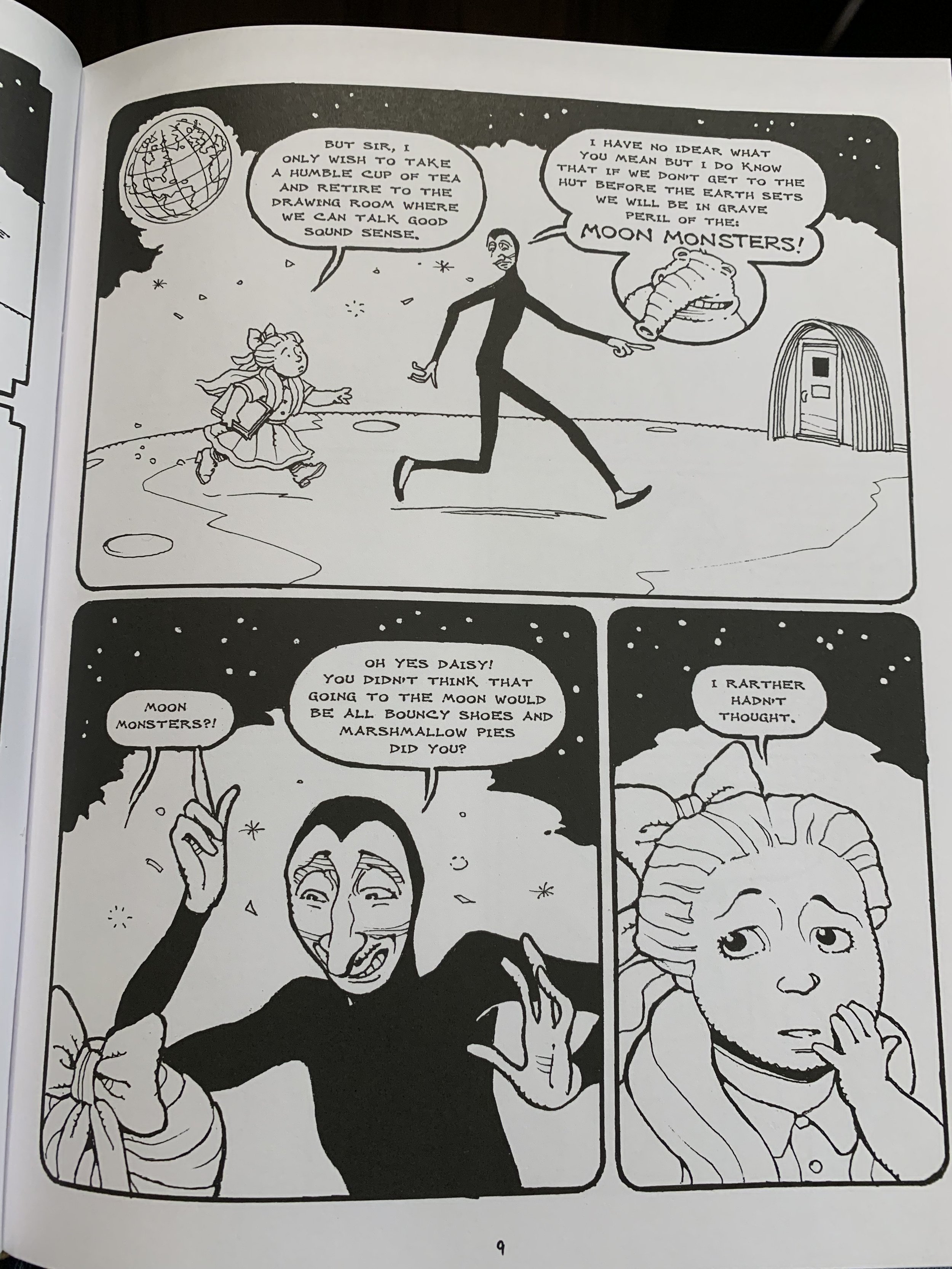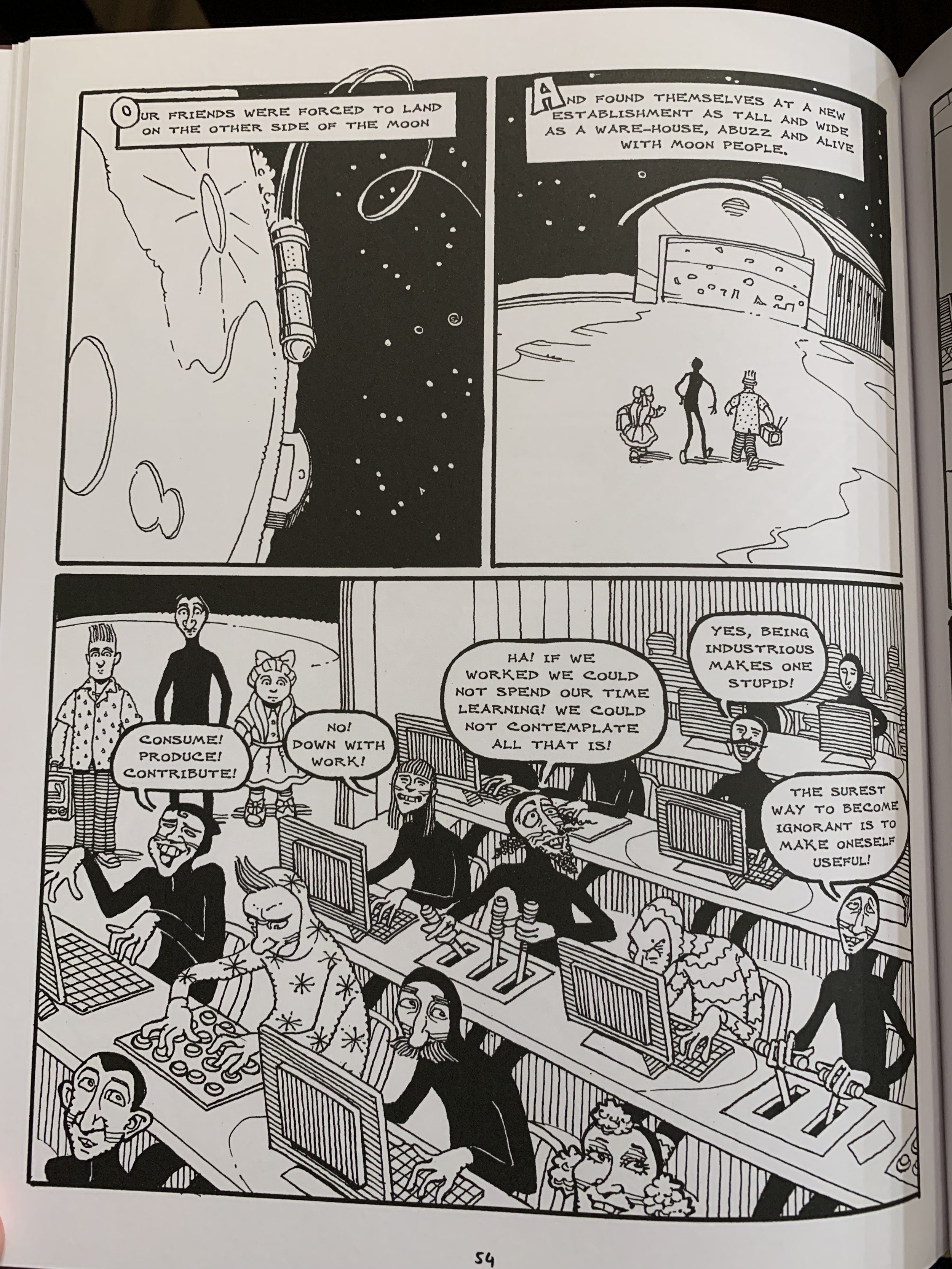The lovely folks at Fantagraphics were kind enough to send me an advance copy of Mathew Klickstein and Rick Geary’s new graphic novel, Daisy Goes to the Moon. I’d say the story itself could be described as an all-ages affair, although the premise has a certain arty intellectualism imbued in its aesthetic. Additionally, the intro and afterword feature some language that is likely to be beyond young readers, including an enthusiastic F-bomb dropped by Klickstein during a recounting of how the project came together. Neither of these sections should be ignored, though, as they provide the essential context needed for a full appreciation of the whimsical tale.
This brings me back to the premise. Our main character is Daisy, a young girl living in Victorian-era England. She is based on the real-life Daisy Ashford. As a young lass, Ashford wrote books and stories that years later reached the eyes of J.M. Barrie, the creator of Peter Pan. Barrie championed Ashford’s work, leading to some recognition and renown for the now-adult Ashford. However, nearly a century later and decades after Ashford’s death, her work has mostly fallen into obscurity. Were it not for the unlikely fandom of iconoclastic filmmaker Harmony Korine, who knows if we would ever have gotten this wonderful book?
See, Klickstein happened upon an interview with Korine wherein he was discussing his love for Ashford’s work. This ignited Klickstein’s curiosity, eventually leading to his penning of a novella starring a diminutive Daisy. Around a decade or so later, Geary, an acclaimed illustrator with a long and multifaceted career, would agree to team up with Klickstein to adapt the novella into a graphic novel. Confused? Don’t be, as all of this is explained much more thoroughly in the aforementioned intro and afterword.
The story itself follows our sassy young heroine as she meets up with a moon man named Zogolbythm. Mr. Z invites Daisy to accompany him back to the moon, and the pair begins their adventure by riding a rocket horseback-style to the lunar surface. There, they will encounter a time traveler named Blahdel, a robot servant, and a temperamental alien from Venus with bad body odor. I won’t even get into the clones, monsters, and the scheming of Daisy’s jealous sister, Angela!
Klickstein pays tribute to Ashford by deploying the affectations of her work. For example, the dialogue features some creative spelling, ostensibly mimicking Ashford’s prepubescent prose. The narrative itself discards any pretenses of traditional structure, as well. I especially enjoyed how the story looped back on itself a couple of times and the jump-cut style of some scene changes. The result is a sort of dreamy anarchy that is purposefully disjointed but pleasingly unpredictable. It’s all very Lewis Carroll meets Georges Méliès.
Geary’s approach is to take all of this in stride. His black-and-white artwork is clean, and his storytelling is clear. A more inexperienced artist may have treated this like a storybook, but his translation of Klickstein’s book is an expertly executed piece of pure sequential art. His panel layouts are varied, ensuring a dynamic read, even while each page is a wonderful tableau that can and should be lingered upon. I love bits like the usage of a speech bubble to double as a panel when Mr. Z warns of the perils posed by the Moon Monsters. His character work is broad but expressive, befitting the all-ages aesthetic. Character designs are consistent and cool, which is imperative for maintaining interest across 81 pages of such a quirky and fragmentary fantasy. Geary makes it look easy, but this is a beautiful graphic novel.
The book itself features embossing on the front and back cover, along with illustrations that convey the tone of the story contained within. The pages are of heavy cardstock, which is to say that they are nice and thick. All in all, this is a nice hardcover package from Fantagraphics that is also affordable with a cover price of only $19.99.
Mathew Klickstein and Rick Geary’s Daisy Goes to the Moon admirably recreates the childlike creativity of a kid enthusiastically relaying a story without the sometimes cumbersome shackles of cause-and-effect rationality. The elegantly uncluttered illustrations perfectly capture the vibe the tale requires. I devoured the book in a single sitting. It’s charming, delightful, surprisingly educational, but mostly just fun. It will hit comic shops and bookstores with taste on January 14th. Highly recommended for fans of outsider art, Victorian-era sci-fi/fantasy, and bratty sisters.
Michael Cavender




